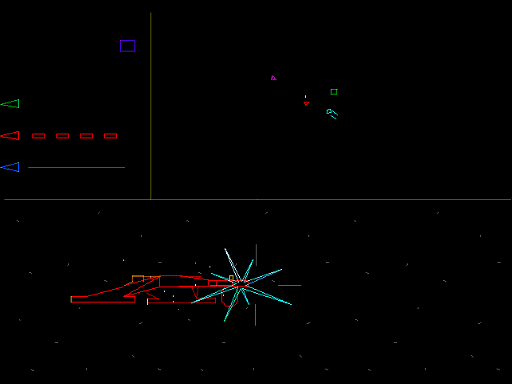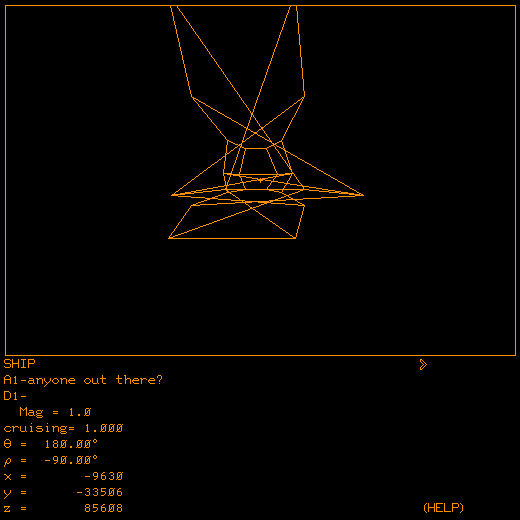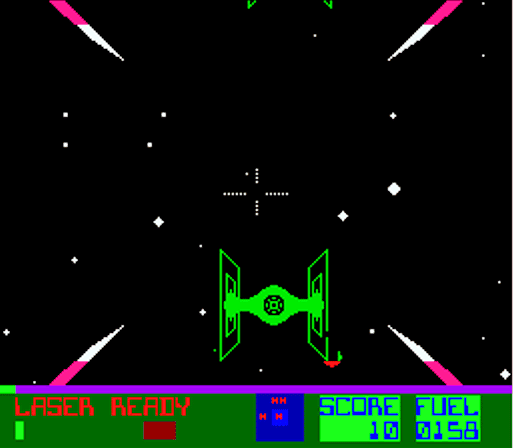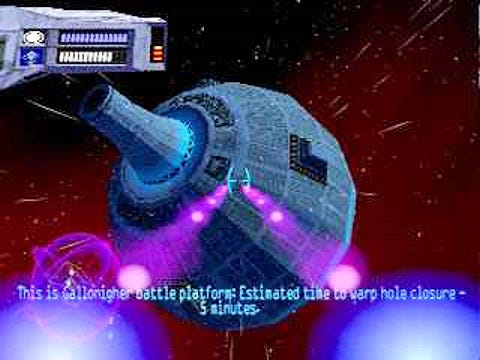Trending
Opinion: How will Project 2025 impact game developers?
The Heritage Foundation's manifesto for the possible next administration could do great harm to many, including large portions of the game development community.
In this game history article, Loguidice and Barton examine Doug Neubauer's 1979 space sim for the Atari 8-bit computers, Star Raiders, "one of those rare games that can truly be said to have been ahead of its time", and the genre it birthed.

[We come to the final entry in the series of Gamasutra-exclusive bonus material originally to be included in Bill Loguidice and Matt Barton's new book Vintage Games: An Insider Look at the History of Grand Theft Auto, Super Mario, and the Most Influential Games of All Time. Here, the authors examine Star Raiders, an innovative Atari game that may not get the credit it deserves. Previously in this 'bonus material' series: Defender, Elite, Tony Hawk's Pro Skater, Pinball Construction Set, Pong, Rogue, Spacewar! and Robotron 2084.]
Karl Marx once famously wrote that "mankind... inevitably sets itself only such tasks as it is able to solve, since closer examination will always show that the problem itself arises only when the material conditions for its solution are already present or at least in the course of formation."[1]
Although many of us may disagree with the bulk of Marx's ideology (or are baffled by such long-winded quotes), here we find a kernel of truth -- especially when applied to game development.
No matter how loudly and brazenly a particular idea or innovation is trumpeted as "original," we can almost always find a clear progenitor, or at least an obvious influence. Did Ralph Baer come up with the idea of a console video game system all on his own? Unlikely.
What is likely, however, was that he was the first man who found himself in possession of the material conditions to make the dream a reality. That he had the idea is almost trivial; anyone could have thought of it. What made Baer unique, however, was that he possessed the knowledge and resources to build his famous Brown Box.


Atari's Star Raiders is the kind of game that needs to be seen in motion to be fully appreciated. From the star fields to the explosions, the animations go a long way to enhancing the game's sparse visuals.
As far as game development is concerned, we already know the ultimate goal, the Holy Grail: the holodeck[2] from Star Trek: The Next Generation. I doubt there is anyone reading this who has not fantasized about such a wondrous device; surely we would never leave a program that gave us something "better than life."[3]


Excerpt from the manual (top) for the original Atari 8-bit version of Star Raiders. The 1982 conversion for the Atari 2600 VCS (bottom) required the inclusion of keypad controllers to accommodate all of the game's features. Neubauer was not directly involved in the creation of either the Atari 2600 VCS release or the 1986 conversion for the Atari ST computer, ST Star Raiders, with some saying the games suffered because of it.
We even have an inkling of how this task might be accomplished, or at least some pretty compelling approaches -- nanotechnology, virtual reality, direct stimulation of the brain; the list goes on. The only thing wanting is the "material conditions" -- that is, the technology, to make this dream possible.
We don't have what it takes to build a holodeck, but we all know what it is and what it must do. The only question is when we'll have the technology to build one. One day, in the far future, we'll have the necessary technology to make a holodeck. But, if the history of video games teaches us anything, it's that we've probably already had it for years.

Box back from Mattel's Space Spartans (1982), an Intellivoice-enabled cartridge for the Intellivision. Space Spartans was one of many Star Raiders knock-offs over the years, and the second one created for the Intellivision after Space Battle (1980). Mattel published a third game in this style, Space Attack (1982), for the Atari 2600 VCS through its M Network label.
[1] See Marx's "A Contribution to the Critique of Political Economy" for free at http://www.marxists.org/archive/marx/works/1859/critique-pol-economy/preface.htm.
[2] The Wikipedia article describes it as such: "The holodeck is depicted as an enclosed room in which objects and people are simulated by a combination of replicated matter, tractor beams, and shaped force fields onto which holographic images are projected. Sounds and smells are simulated by speakers and fragranced fluid atomizers, respectively. The feel of a large environment is simulated by suspending the participants on force fields which move with their feet, keeping them from reaching the walls of the room (a virtual treadmill)."
[3] See Grant Naylor's Better than Life novel or watch the Red Dwarf episode by the same name (Grant Naylor is the collective name used by writers Rob Grant and Doug Naylor).
Doug Neubauer's Star Raiders, a 1979 game for the Atari 8-bit line of personal computers, is a shining example of what happens when a developer is told that something can't be done, does it anyway, and then is promptly forgotten for having done it. Star Raiders is one of those rare games that can truly be said to have been ahead of its time.
It was 1979, and we already had a game that offered high-speed first-person perspective through a fully navigable 3D-like environment in just 8K of RAM (memory) and 8K of ROM (storage)[4].
While most gamers were busy blasting aliens in the almost schematic Space Invaders (book Chapter 16, "Space Invaders (1978): The Japanese Descend"), Star Raiders put them in the cockpit. It established many of the conventions of the "space sim" genre that would rise to prominence most famously with Firebird's Elite (bonus chapter, The History of Elite) and Origin's Wing Commander (1990).
Unlike the vast majority of space-based shoot 'em ups of the era, Star Raiders offered a first-person view straight from the pilot's seat. The mission seemed simple enough -- protect the Atarian Federation's star bases while destroying Zylons. Lest pacifist players opt for diplomacy, the manual instructed players (in all caps) to "DESTROY ALL ZYLON STARSHIPS ON SIGHT, SHOW NO MERCY."
Though it's not clear why the Zylons are so eager to destroy the Atarians, it might well be the result of a trademark infringement suit gone horribly wrong. Besides the obvious references to the Cylons from Battlestar Galactica and the "photon torpedoes" from Star Trek (complete with impressive "sparkling" energy effect), the "Zylon fighter" ships look suspiciously like the Imperial Tie Fighters from Star Wars. It's a cornucopia of unauthorized 1970s sci-fi riffs!

Screenshot from Sega's Star Trek: Strategic Operations Simulator arcade game from 1982, where the player controls the starship Enterprise, and must defend sectors from invading Klingon ships. Despite countless games inspired by the property up to that point, Star Trek: Strategic Operations Simulator was only the second officially licensed videogame released after the modest Star Trek: Phaser Strike (1979) for the Milton Bradley Microvision handheld.

Screenshot from Atari's Star Wars arcade game from 1983, among the first official Star Wars videogame translations.
Besides the mandate to destroy all Zylons, the player also had to worry about running out of fuel, colliding with meteors, or losing vital ship components after a battle, all in real-time. Thankfully, players could "hyperjump" in a visually impressive manner to friendly starbases to repair and refuel. Critics raved about the dynamic visuals and superb audio.
Of course, the game's high-quality audio shouldn't surprise us; Neubauer himself designed the Atari's POKEY audio chip.[5] The chip was also used in some of Atari's arcade machines and select cartridges for the Atari 7800 console.

Wing Commander (1990) offered Star Raiders-like combat wrapped around a fun sci-fi story. The fantastic audiovisuals and intense action made it the biggest hit for Origin since the Ultima series. PC version shown.
Besides the impressive strides in the ability to perform multiple tasks at once and its audiovisuals, Star Raiders also introduced - in lieu of a final score -- a rank system that would show up in Elite and other future space sims. Players started off as "novices," but could become pilots, warriors, and commanders at higher levels.
Even though Star Raiders was one of the best-known games for Atari's 400 and 800 computers, its author did not make any profit, because Atari didn't grant royalties to its developers. Atari's stingy policy eventually led to Neubauer's departure, though he would return later to do contract work.

Star Wars: X-Wing (1993) brought Wing Commander-style gameplay into George Lucas's famous fictional universe. It was a dream come true for Star Wars fans, with many games like it to follow. PC version shown.
[4] Neubauer laments that with more memory and storage he could have created an even more impressive game, adding planet landings, a trench scene and more charts. See http://www.atarihq.com/othersec/library/neubauer.html.
[5] The POKEY chip is also present in the Atari 5200 console, which is functionally similar to an Atari 400 computer. The 5200 received a nearly identical Star Raiders conversion in 1982.
Like several games in this book, Star Raiders was preceded by a game for the highly innovative PLATO platform. In this case, the game was Spasim, described by its author Jim Bowery as follows:
"Spasim was a 32-player 3D networked game involving 4 planetary systems with up to 8 players per planetary system, flying around a space in which the players appeared to each other as wire-frame space ships and updated their positions about every second.
At its initial release in March of 1974, the game was a simple team-based phasers-and-photon-torpedoes Star Trek-type game, mixed with multi-player first-person-shooter dynamics. You had to direct your movement in polar coordinates, but calculate your positions in Cartesian coordinates.
By this conceit, I was able to position Spasim as an educational game so that it would be supported on the PLATO network, which was for computer-based education."[6]
Atari and top developers like Bruce Artwick (see book Chapter 8, "Flight Simulator (1980): Digital Reality") had PLATO accounts and may well have seen and been inspired by the many groundbreaking games for PLATO.
Still, PLATO was an exponentially more powerful system than the humble home computers of the era. It says something about the skill of Neubauer that he was able to adapt such an ambitious game for Atari's 8-bit computers.
Star Raiders was also preceded by Atari's Starship I (1976) arcade machine and the rather crude home translation, Star Ship (1977), for the Atari 2600 VCS. Though certainly ambitious, the game's wretched implementation -- even by 1977 standards -- caused it to be one of the first Atari pulled from market.[7]

Spasim is one of many pioneering games for the PLATO platform, which both preceded and remained far ahead of the home computer scene into the early 1980s.
Neubauer credits several inspirations for Star Raiders, though the most important seems to be an unauthorized Star Trek mainframe strategy game. According to Neubauer, this all-text game had "ship damage and sector scanners and charts," as well as a ranking system.[8]
Thus, Neubauer's main contribution was adapting these existing concepts for use in a fast action 3D game.

Screenshot from Exidy's 1979 Star Fire arcade game.
Star Raiders was one of many sci-fi games that followed the success of George Lucas's Star Wars. Other examples include Cinematronic's Starhawk (1977) and Exidy's Star Fire (1979), which is also known for being the first arcade game with an initial-based high score table. Arcade gamers wouldn't see an authorized title until 1983, when Atari released its vector-based Star Wars machine.
Like Star Raiders, Star Wars was a first-person game that focused on dogfighting. What's interesting is that by the time that Hollywood finally got around to issuing licensed games based on its bestselling franchises, they had little to do but reimagine products created years earlier by programmers like Neubauer.

Screenshot from Neubauer's Star Raiders sequel for the Atari 2600 VCS, Solaris (1986), which exceeded the original game in many ways. Star Raiders II, which started life as a game based on The Last Starfighter (1984) movie without Neubauer's involvement, was released, sans license, in 1986 for Atari 8-bit computers, with conversions for the Amstrad CPC, Commodore 64 and ZX Spectrum following a year later. Though featuring improved audio-visuals, some critics argued that the game lacked the intensity of the original Star Raiders.
Star Raiders represented a remarkable programming feat for its era, paving the way for later classics like Atari's Star Wars, Firebird's Elite, and Origin's Wing Commander. It's without question one of the best games for the Atari 8-bit series of computers. Though mostly played today only by Atari 8-bit fans, Star Raiders is nevertheless a stellar achievement, well worth the attention of any serious videogame enthusiast.

Screenshot from the 3DO version of Wing Commander III: Heart of the Tiger (1994), one of the entries in the Wing Commander series that featured full-motion video and starred well known actors like Star Wars's Mark Hamill.

Screenshot from Psygnosis's Colony Wars (1997), the first game in a series of visually impressive Sony PlayStation mission-based space combat simulations that can trace their lineage back to Star Raiders. Though sporadic, space combat simulations continue to be released today on a variety of platforms.
[6] http://www.geocities.com/jim_bowery/spasim.html.
[7] There were several home computer games based on similar concepts, such as Chris Freund's X-Wing Fighter and X-Wing II for the TRS-80, and Space Shooter and Astar's Star Force for the Commodore PET, which made their appearances in the late 1970s. However, these games had simplistic graphics and no sound.
[8] See http://www.atarihq.com/othersec/library/neubauer.html.
[EDITOR'S NOTE: For more information on the making of Star Raiders, Gamasutra's 2007 profle of the game includes comments from creator Neubauer.]
Read more about:
FeaturesYou May Also Like